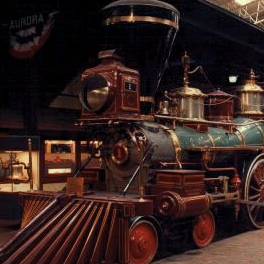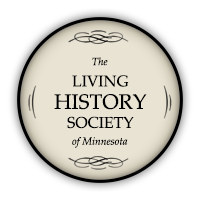You are cordially welcomed to the
Living History Society of Minnesota
From Minnesota’s Early Statehood through the American Civil War
Research & Learning
Special Interest Groups
The M&P Railroad Company
Purpose

Because of the LHSMN’s emphasis on all aspects of civilian life during the years 1858–1865, it was important that certain programs should be created that would help educate the public as to the daily activities and interests of non-military men during the Civil War Era. As a result, the M&PRR Company was formed with the intention of providing the gentlemen of the Living History Society a ready impression for every venue and the opportunity of interpretive interaction with the public during LHS events.
History
Incorporated May 22, 1857 by act of the Minnesota Territorial Legislature, the Minnesota & Pacific Railroad Company was one of four such companies created to take advantage of the February 9, 1857 federal land grant act. In order to legally acquire lands as provided, the M&PRR had to construct a line originating in Stillwater on the St. Croix River, via St. Paul and St. Anthony, to Big Stone Lake on the proposed western border of the soon to be state of Minnesota.
Minnesota’s population in the ten years preceding statehood grew by 3000%, during a period of rapid expansion and growth in the rest of the region and nation. The Panic of 1857 started in New York early in the year, but Minnesotans were confident that the frontier was immune from cyclical boom and bust cycles since we did not have as many banks (banks were an evil necessity according to Jacksonian Democrats of the day). However, by late summer hard money had disappeared on the streets of St. Paul, banks closed, and everyone was suspicious of paper money — particularly if it originated anywhere other than the Territory.
Minnesotans looked to a promising harvest and statehood to revive their economy. The depression continued throughout 1858 despite the joyous news of statehood on May 11. To further stimulate the economy, and to get speedy, reliable transportation, the people approved an amendment to the new state constitution providing four railroad companies access to proceeds of public bonding dollars in the amount of $5 million. Gov. Henry H. Sibley, a Jeffersonian Douglas Democrat, opposed the Five Million Loan as detrimental to the state’s credit rating. The railroad companies petitioned the State Supreme Court for a Writ of Mandamus, a court power that requires a public official to carry out a law. Once granted Gov. Sibley released the funding against his better judgment, he set about selling bonds in New York to meager success.
The M&PRR surveyed its line from Stillwater to St. Paul, and then graded and bridged a line from St. Anthony to Crow Wing. It acquired ties, but was unable to afford rails, engines or rolling stock in order to meet terms of the Five Million Loan. The Minnesota Legislature granted an extension due to severe economic times, which provided the company time to consider both its obligations and options. By 1860, it needed new investors and more money. In 1862 with the help of New York investments the first operating railroad in the state ran from the lower levee at St. Paul to the Falls of St. Anthony, a distance of ten miles.
M&PRR had succeeded but its corporate structure was forever changed by outside investments. It reorganized as the St. Paul & Pacific Railroad Company, which in turn became part of James J. Hill’s Great Northern Railway Company. The state refused its bonds and subsequently ruined its credit rating for 40 years. Gov. Sibley did not run again in 1860, and retired from politics until he served one term in the House of Representatives in 1871 specifically to fix the bond situation. His bill never passed the Legislature, and he retired from politics permanently — disgusted with the black mark on his gubernatorial record.
Project
The M&PRR members research aspects of the railroad’s colorful history, recreate company documents and maps, and prepare educational interpretive skits for the edification of the public.
Links
- James J. Hill House
- Sibley House Historic Site
- James J. Hill Reference Library
- Lake Superior Railroad Museum which houses the William Crooks, first locomotive on the M&PRR
- Minnesota Transportation Museum
- Minnesota from the Railroad by the Minnesota Historical Society
